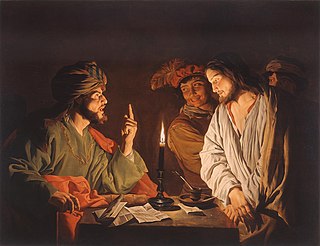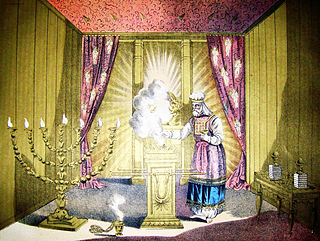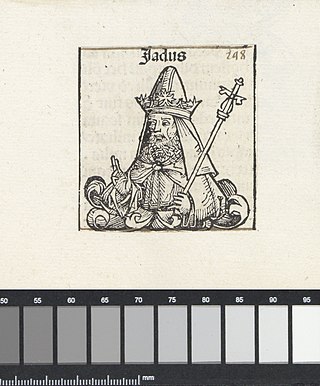Related Research Articles
Abilene or simply Abila was a plain, a district in Coele-Syria, of which the chief town was Abila Lysaniou. The limits of this region are nowhere exactly defined, but it seems to have included the eastern slopes of the Anti-Lebanon range, and to have extended south and southeast of Damascus as far as the borders of Galilaea, Batanaea, and Trachonitis. According to Flavius Josephus, Abilene was a separate Iturean kingdom until 37 AD.
Annas was appointed by the Roman legate Quirinius as the first High Priest of the newly formed Roman province of Judaea in AD 6 – just after the Romans had deposed Archelaus, Ethnarch of Judaea, thereby putting Judaea directly under Roman rule.

Josef Ben Caiaphas, known simply as Caiaphas in the New Testament, was the Jewish high priest during the years of Jesus' ministry, according to Josephus. The Gospels of Matthew, Luke and John indicate he was an organizer of the plot to kill Jesus. He famously presided over the Sanhedrin trial of Jesus. The primary sources for Caiaphas' life are the New Testament, and the writings of Josephus. The latter records he was made high priest by the Roman procurator Valerius Gratus after Simon ben Camithus had been deposed.

Theophilus was the High Priest in the Second Temple in Jerusalem from 37 to 41 CE according to Josephus's Antiquities of the Jews. He was a member of one of the wealthiest and most influential Jewish families in Iudaea Province during the 1st century. A growing but still uncommon belief points to High Priest Theophilus as the person to whom the Gospel of Luke is addressed, but Theophilus is a common enough name that there are many other possibilities for the addressee of Luke's Gospel and the Acts of the Apostles. In its favor is the fact that in Luke Theophilus is called by the title Most Excellent (kratiste), indicating he held a political office like high priest, the ethnarch under the Romans. In Acts 1:1 he does not have this honorific indicating that he no longer held an office of the Roman government. This provides an unusual identifier that eliminates other candidates for whom such a change in office was not effected.

Judah Aristobulus I, or Aristobulus I (; Greek: Ἀριστόβουλος, romanized: Aristóboulos was the High Priest of Israel and the first Hasmonean king of Judaea, reigning from 104 BCE until his death the following year. He was the eldest of the five sons of John Hyrcanus, the previous leader. The Roman-Jewish historian Josephus states that he was the first Jew in "four hundred and eighty-three years and three months" to have established a monarchy since the return from the Babylonian captivity. Aristobulus was the first Hebrew king to claim both the high priesthood and the kingship. The Sadducees and the Essenes were not concerned about Aristobulus taking the title of king, but the Pharisees, believing that the kingship could only be held by the descendants of the Davidic line, strongly opposed this. They launched a massive rebellion, but Aristobulus died before any attempt to depose him could be made.
Theophilus is the name or honorary title of the person to whom the Gospel of Luke and the Acts of the Apostles are addressed. It is thought that both works were written by the same author, and often argued that the two books were originally a single unified work. Both were written in a refined Koine Greek, and the name θεόφιλος ("Theophilos"), as it appears therein, means friend of God or (be)loved by God or loving God in the Greek language. The true identity of Theophilus is unknown, with several conjectures and traditions around an identity. In English Theophilus is also written "Theophilos", both a common name and an honorary title among the learned (academic) Romans and Jews of the era. The life of Theophilus would coincide with the writing of Luke and the author of the Acts.

John Hyrcanus II, a member of the Hasmonean dynasty, was for a long time the Jewish High Priest in the 1st century BCE. He was also briefly King of Judea 67–66 BCE and then the ethnarch (ruler) of Judea, probably over the period 47–40 BCE.

In Judaism, the High Priest of Israel was the head of the Israelite priesthood. He played a unique role in the worship conducted in the Tabernacle and later in the Temple in Jerusalem, as well as in some non-ritual matters. Like all priests, he was required to be descended from Aaron. But unlike other priests, the high priest followed more restrictive laws, wore unique priestly garments, and was the only priest allowed to perform certain ceremonies.
Joshua ben Gamla, also called Jesus the son of Gamala, was a Jewish high priest in about 64-65 CE. He was killed during the First Jewish–Roman War. While the Talmud refers to Joshua ben Gamla, the earlier Greek works of Josephus Flavius call him Γαμάλα μὲν υἱὸς Ἰησοῦς a semitism for: The son of Gamala, Jesus.

In the New Testament, the Sanhedrin trial of Jesus refers to the trial of Jesus before the Sanhedrin following his arrest in Jerusalem and prior to the trial before Pontius Pilate. It is an incident reported by all three Synoptic Gospels of the New Testament, while the Gospel of John refers to a preliminary inquiry before Annas. The gospel accounts vary on a number of details.
Valerius Gratus was the 4th Roman Prefect of Judaea province under Tiberius from 15 to 26 CE.
"This Jesus Must Die" is a song from the 1970 album and 1971 rock opera Jesus Christ Superstar by Tim Rice and Andrew Lloyd Webber, which also appears in the film version of Jesus Christ Superstar, and on the album of the musical. In the 1973 film, it is sung primarily by Bob Bingham as Caiaphas and Kurt Yaghjian as Annas; and on the 1970 album, by Victor Brox as Caiaphas and Brian Keith as Annas, with Paul Raven and Tim Rice providing the voices of the priests. In the 2000 film it is sung by Frederick B. Owens as Caiaphas and Michael Shaeffer as Annas.
Joiada is a name found from the form "Jehoiada" in the Hebrew Bible and used alternately in English versions.
"The Jeshanah Gate was repaired by Joiada son of Paseah and Meshullam son of Besodeiah. They laid its beams and put its doors with their bolts and bars in place"
Johanan, son of Joiada, was the fifth High Priest of the Temple in Jerusalem after it was rebuilt after the end of the Babylonian captivity. His reign is estimated to have been from c. 410–371 BCE; he was succeeded by his son Jaddua. The Hebrew Bible gives no details about his life. Johanan lived in the province of Yehud Medinata in the Achaemenid Empire during the reigns of emperors Darius II and his son Artaxerxes II.
Eliashib the High Priest is mentioned in Nehemiah 12:10,22 and 3:1, 20-21,13:28 and possibly the Book of Ezra of the Hebrew Bible as (grand)father of the high priest Johanan. Some also place him in different parts of Nehemiah including 12:23 and 13:4,7, but this is disputed. Nehemiah 3:20-21 places his home between the area of two working groups constructing the walls of Jerusalem on the south side of the city. He helped with the refortification of this wall. The size of his house indicated his wealth and high socio-economic status. This places him as someone who lived during the time of Nehemiah. In the year 445 BCE, Eliashib was the high priest when Nehemiah returned to Jerusalem in the 20th year of Artaxerxes I.

Jaddua was a son of Johanan and a high priest during the post-exilic period. However, according to Nehemiah 12:22 it is possible that a transcribing error has occurred in the rendering of Jaddua's father's name. A more likely translation is that Jaddua's father was Johanan.. Reference to Jaddua may be found in Nehemiah verses 12:11,22. When reading Josephus' accounts of Jaddua's priestly position, it is unclear whether or not Jaddua was the sole high priest or if he shared the office with Manasseh. The other possibility is that Manasseh was Jaddua's assistant or sagan..
Joiakim is the name of a priest mentioned in the Hebrew Bible, in Deuterocanonical books, and in later extra-biblical sources. Reconstructing his role in history is complicated by a variety of claims made in these texts. The chronology of Joiakim's tenure as priest has been the subject of dispute, as has the question of whether Joiakim was high priest. The Hebrew Bible, which mentions Joiakim only in the Book of Nehemiah, Chapter 12, does not call him "high priest," though Josephus does use the term for him.
Ishmael ben Fabus also known as Ishmael ben Phiabi and Ishmael ben Phabi was a High Priest of Israel in the 1st century CE. He was High Priest of Israel from 15 CE to 16 CE under the Roman procurator, Valerius Gratus, and is thought to be the same High Priest who was reinstated by Agrippa in 58 CE to 62 CE.
Joshua ben Sie also known as Jesus ben Sie was a Jewish High Priest of Israel at the end of the 1st century BC. He replaced Eleazar ben Boethus from 3 BC.
References
- ↑ James C. VanderKam. From Joshua to Caiaphas: High Priest after the Exile (Fortress, 2004).
- ↑ Robert Killian The Holy Bible "Chronicle" of Sequential Biblical Events (AuthorHouse, 2012).
- ↑ High Priests of the Second Temple Period.
- ↑ Yoma 47a
- ↑ Josephus, Antiquities 18.2.2.
- ↑ N. L. Kuehl, 1997 A Book of Evidence (Chapter Four).